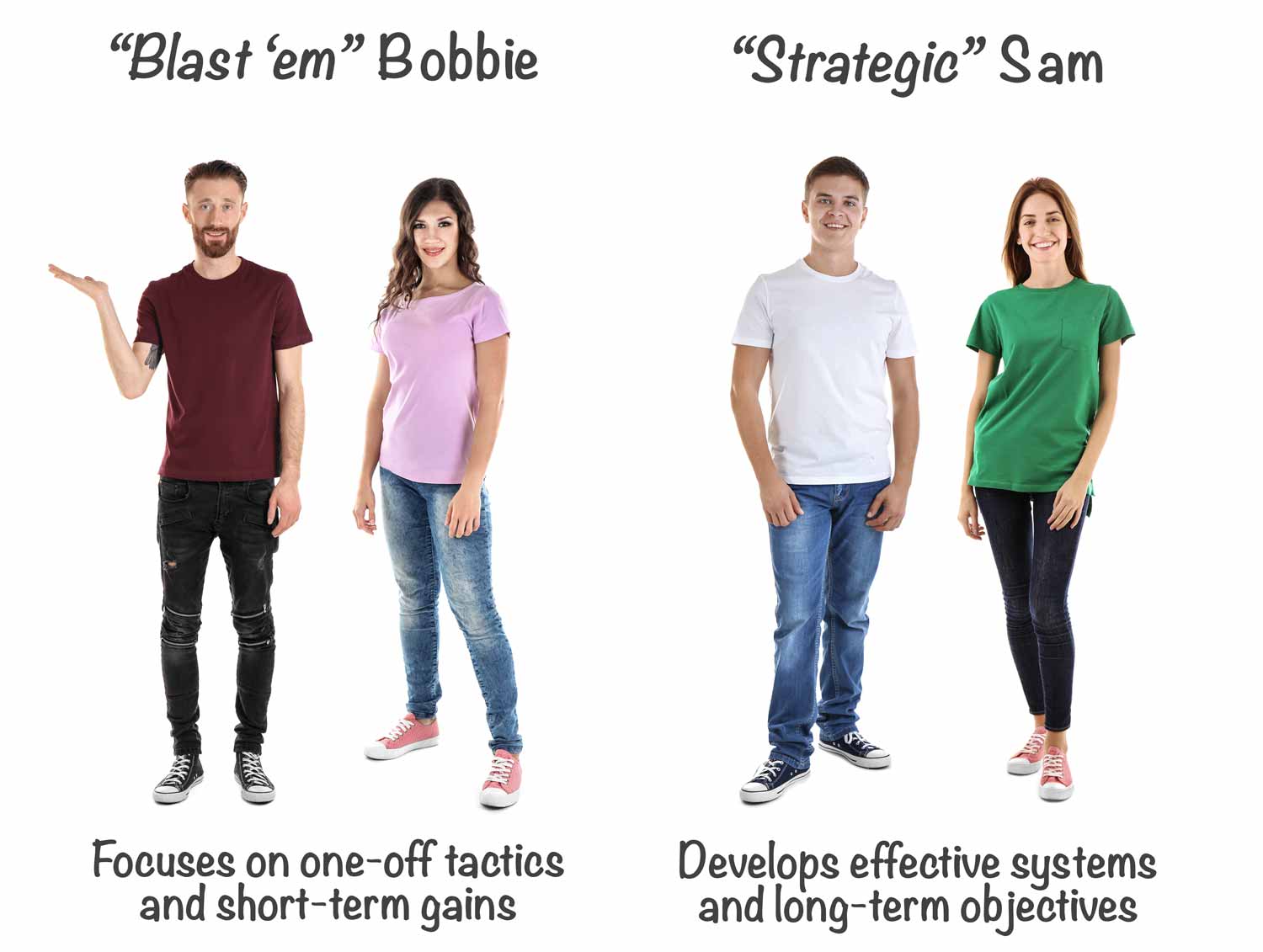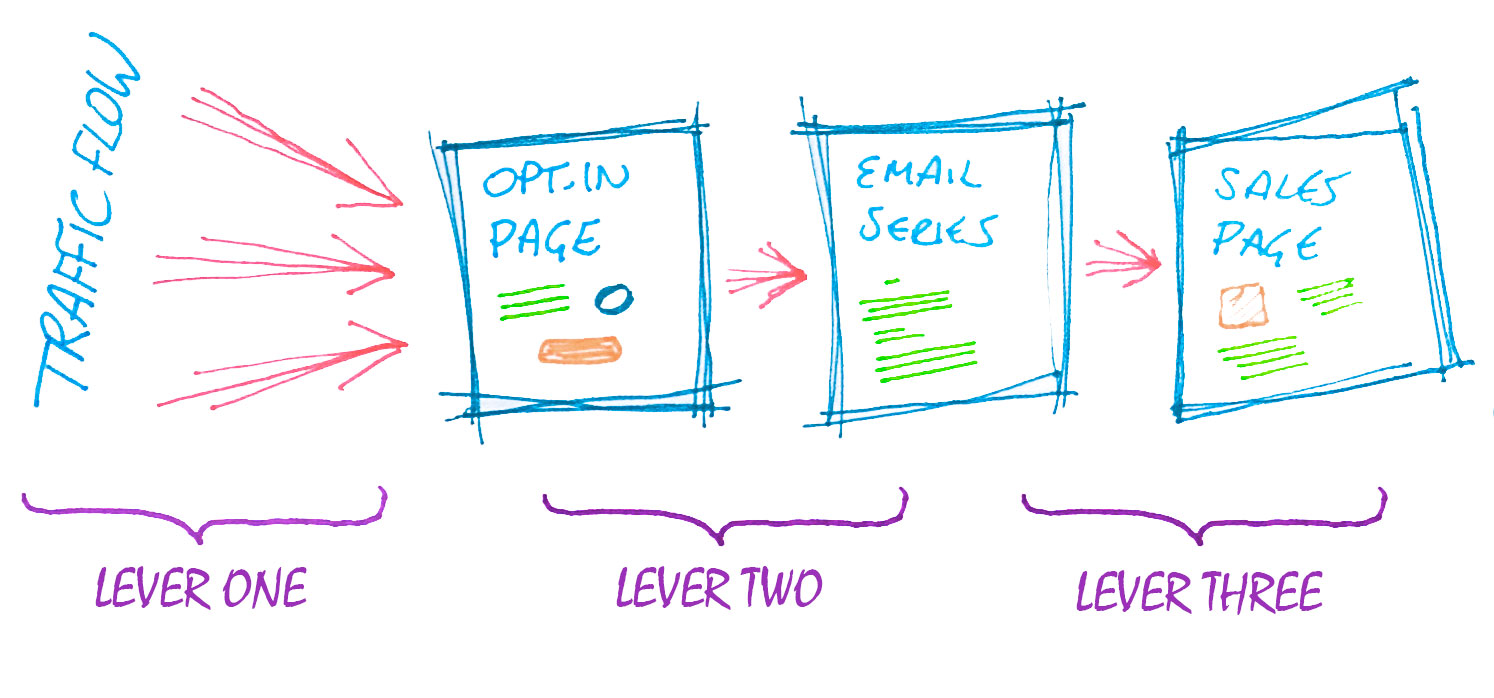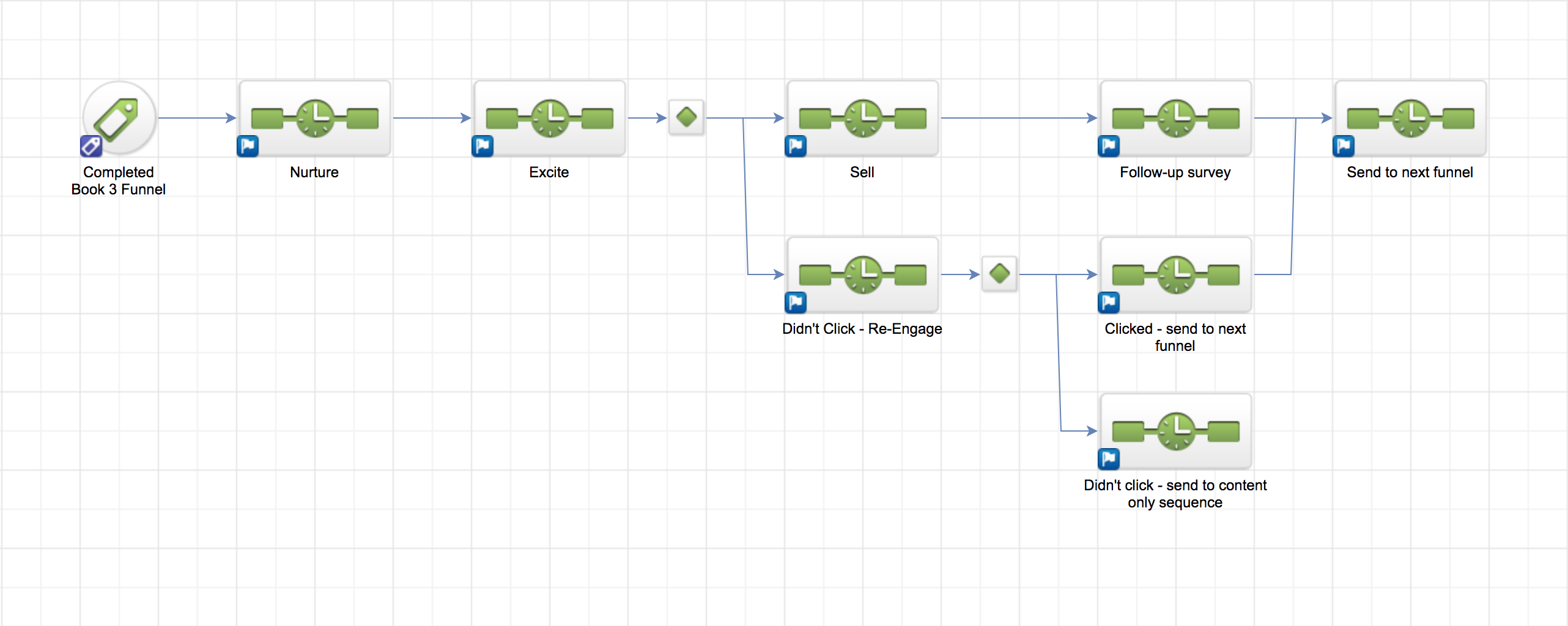
^^ When you perfect a system you can automate it. When you automate it, you can scale it up. There are three key drivers or “levers” to growing this system.
In the earlier EMU lessons we covered a comprehensive structure to “create great content” for your emails – no matter what genre you write.
Then, on the previous page, I showed you a strategy for turning “random emails” into an automated system that leads readers through the journey from “getting to know you” to “loving you and buying from you”.
I introduced you to the idea of “stacked funnels” and segmentation, and how to use automated emails to discover your best subscribers, convert unengaged readers into fans, and create seamless – and evergreen – promotional sequences for both new and old subscribers.
(Which you can continue to build and layer up over time as you write more books and email content).
“With all this in place, now it's time to look at how we can take this automated email system and scale it up - without creating a whole host of extra stress for you.”
But first…
If you missed Part 1, Part 2, Part 3, Part 4, or Part 5, make sure you catch up before reading this – or you’ll be missing out vital pieces of the puzzle.
Cool? Okay, let’s jump in.
![]()
Before I show you the three growth levers, we’re going to go back and visit our heroes / heroines of this story – “Blast ’em Bobbie” and “Strategic Sam” for just a moment.
Because these guys approach learning in very different ways too. And the whole purpose of this EMU series is not just to give you a bunch of information, but to help you actually make it work for YOU.
Meaning, these “growth levers” won’t help you unless you’ve assimilated the learning we’ve been through already, and made a plan to get it up and running.
I’ll explain…
Here’s Bobbie and Sam again:

Bobbie’s approach to learning involves watching lots of youtube videos, listening to podcasts, and purchasing the occasional online course. Bobbie consumes a lot of material, gets lots of “ideas” but doesn’t know how it all fits together. Bobbie tries out random “tactics” and loses enthusiasm if they don’t work right away. Bobbie picks and chooses tactics but has no overall long-term strategy, and never fully executes on the learning material.
Sam knows exactly where there are gaps in the business strategy. Sam chooses learning material very carefully, and only commits time to learning if the material fits the business objectives and improves the overall strategy. When Sam commits to learning something new, Sam EXECUTES the learning immediately, then measures the results, refines, tweaks, and improves the outcome. Sam knows exactly what to learn, when to execute, and how to adapt the learning to suit the business’ key objectives and circumstances.
Bobbie spends a lot of time watching videos and listening to podcasts on a variety of topics. Sam spends less time “consuming random content” and more time learning the RIGHT things and executing on them immediately.
Bobbie likes to feel “busy”. Sam values a more important resource – time. Where Bobbie gets frustrated that new ideas “just don’t work”, Sam has figured out which ideas suit and how they can be implemented.
![]()
With so much “learning material” available, you can find the answer to pretty much anything with a few clicks.
The problem comes when you don’t know what question to ask. Or, when the “content” you find doesn’t give you the full picture.
It’s not surprising that so many people buy online courses, watch the videos or go through the lessons, and then… do nothing.
It’s become a habit. Ingrained through years of easy Youtube videos and click-happy blog articles (“The Top 7,678 Marketing Tips for Authors!” ugh).
Everybody wants a thirty-second idea that’s going to change everything. And that vast majority of content out there is designed just for the “Blast ’em Bobbie”s of the world. Easy, short, and feel-good.
But that’s not how life – or business – works.
Learning something new means forming new pathways in your mindset. And that can’t be done with a five-minute Youtube video or a Podcast interview.
And “learning” is just the beginning. There’s more work to be done.

Executing and Refining / Adapting are key to making this all work. With that said, keep it in the back of your mind. And let’s move on:
![]()
When you first get started, the idea of building a “machine” or system that looks – and performs – like the ones I showed you on the previous page, probably feels a little overwhelming.
But remember – you’ll start off simple, then layer up and iterate over time.
Avoiding what I like to call “MouseTrap Syndrome”.
Remember that board game?

A ridiculously over-engineered contraption that broke all the time and made you want to hurl things across the room (preferably at the person who invented it).
We’re not going to do that.
Start simple. Refine, tweak, test. Then layer up slowly over time.
With that in mind, as you build out your system there are some very specific things to keep an eye on…
And that’s where Growth Levers come in. A way for you to narrow down your efforts to get the most effective results.
I’ll explain.
With a system that turns traffic into leads, and leads into sales, there are three core “growth levers” you can focus on to get exponential growth:
Again, you need to have executed on actually “building the system” before any of this will help you.
Here’s the cool part about growth levers.
If you want to double your business, you can focus on improving each “lever” by a more modest amount, and enjoy cumulative gains.
 ^^ This next part includes some maths – but don’t worry, it’s not rocket science
^^ This next part includes some maths – but don’t worry, it’s not rocket science
But what if we improve each one of those “growth levers” by a modest 30%?
See how it works? With a solid-but-attainable 30% improvement to each of the key “levers”, Jan just more than doubled her monthly revenue from new subscribers.
When Jan applies this methodology to her other “funnels”, they can more than double revenue there, too.
When you get to the point where you have multiple funnels (dealing with different readers at different stages, or for different books, series, genres, or pen names) if you can achieve that modest-but-powerful 30% improvement, you’ve just doubled results all across your business.
And, you know what? When you first start building these systems out, there will be plenty of room for improvements.
 ^^ Across the entire funnel, or series of multiple funnels, you can see the metrics and make adjustments on the fly – focusing on what matters most (instead of going crazy trying “everything”).
^^ Across the entire funnel, or series of multiple funnels, you can see the metrics and make adjustments on the fly – focusing on what matters most (instead of going crazy trying “everything”).
Chances are, you won’t. Not for quite a while, at least. But when you’ve optimised traffic, opt-ins, and conversions-to-sale as far as you can, there are other more “advanced” levers you can use.
Average Order Value (AOV). If Jan’s AOV is currently $4.99, what can she do to boost that by 30% too? Perhaps she can put up prices. Or offer an upsell. Or a higher-priced alternative.
But perhaps your core product line (eg – ebooks) doesn’t sell too well at $6.49. Maybe there’s an “enhanced” offering you can make. For example:
If you sell 90 products at $4.99 and 10 “enhanced” products at $20, your AOV is also $6.49 (30% improvement)
Those are just a couple of examples. There are ways to boost AOV without alienating your fan base (boxed sets, hardcovers, audiobooks, artwork, signed copies, special editions, courses, coaching, software… the list goes on).
Ok, Jan has optimised her systems to the point where she can’t boost opt-ins or conversions by any meaningful amount. And it’s getting tricky to get more traffic without investing in a larger ad spent or diversifying her business.
No problem. Now we’ve boosted AOV by 30%, that $439.12 per month is now 571.12 (another 30% increase in monthly revenue from that funnel).
 ^^ There’s a reason why people line up to buy again and again and again. This is the last “lever” we’ll cover.
^^ There’s a reason why people line up to buy again and again and again. This is the last “lever” we’ll cover.
Jan looks at her “read through” rate and other stats and calculates that each buyer purchases, on average, 2.3 products from her.
With an AOV of $6.49 that means each buyer will spend $14.93, on average.
Jan has optimised her AOV as far as she can. But she can still pull on the AOF lever to get her readers to buy MORE OFTEN.
With 8 books, Jan knows there are a significant number of titles that people don’t get round to buying. So Jan works on some new funnels to lead people towards the later books, and plans promotions around her series.
Jan executes on the plan, measures, tests, and refines. Now, on average, readers purchase 3 products from her, at an average order value of $6.49.
The total spend by each customer is now $19.47 (30% improvement).
Where before her 88 new buyers per month would spend a total Lifetime Value (LTV) of $1,313.84 (88 x $14.93), now they will spend $1,713.36 (88 x $19.47) – again, a 30% increase.
 ^^ Don’t get caught up trying to juggle 5,678 different tactics – focus on your core “growth levers” to simplify and scale up
^^ Don’t get caught up trying to juggle 5,678 different tactics – focus on your core “growth levers” to simplify and scale up
By focusing on these key “growth levers”, Jan has increased her monthly revenue from new subscribers from $199 to $571. Almost tripling it. Jan also significantly increases her revenue in her other funnels – with existing subscribers – in the same way.
Her 88 buyers a month are now spending more and buying more often. Meaning the 1,056 buyers Jan gets every year now spend a total of $20,560 with her, on top of the $19.47 Jan earns from every existing buyer on her list.
Putting that in perspective, if Jan has a list of 10,000, and 26% (2600) are buyers, that asset is now worth a total of $50,600.
(And this is all on top of sales Jan will make from customers on Amazon who aren’t on her list).
All from 338 new subscribers per month. Which is not beyond the realms of achievable for anybody reading this page. And the total numbers go up as your subscriber numbers increase.
This is a lot to digest. So let’s break it down.
![]()
It’s common for authors – and entrepreneurs in general – to “know they need to do something”. So they try everything they possibly can.
Which usually means playing around with:
Sound familiar?
This is the world “Blast ’em Bobbie” lives in. “Strategic Sam” has a different approach, and focuses on how a particular marketing activity will improve the key drivers to grow the business’ objectives.
Meaning, instead of getting caught up in “author marketing hell”, focus on your “growth levers” and ask yourself: does this particular marketing activity:
If there’s no clear “yes” to those questions, move on.
 ^^ It starts with the right foundations. Orange workers optional.
^^ It starts with the right foundations. Orange workers optional.
Now, the example of “Jan” above is, of course, just an exercise to show you how the numbers work, and how by focusing on modest improvements across a range of “growth levers” you can significantly improve your results across the board.
Reality often looks different. You might only get a 10% improvement in some areas. Maybe you can get a 40% or 50% improvement in others. Some traffic might perform better than others. It will depend on your business and your circumstances, but those improvements are there for the taking.
(Unless, of course, you already have a ruthlessly optimised marketing system in place already, that you’ve tested and refined for years… but chances are you don’t).
But with a full email marketing system in place, you can see where the improvements need to be made, and which funnels perform best. You don’t have to “guess” any more. You don’t have to “try everything” in the hope that something will stick.
![]()
The upshot is – all this takes work. You need to have your email marketing nailed. You need to build your systems and funnels and EXECUTE on the learning. You need to optimise them for the best results. Then you need to iteratively tweak, refine, and improve your “growth levers” to scale up and grow.
This is a lot of work. But it’s worthwhile work.
“It's not supposed to be easy. Anyone who finds it easy is stupid.”
I’ve developed something new – a “concept” that I believe will help you achieve this. And help you build your email-marketing strategy, your content framework, and build your first “funnel”. In other words, help you EXECUTE on the learning and adapt this framework to suit your personal circumstances and your specific business.
But before I get to that, I want to re-iterate the core principles behind this EMU series – and reinforce what I’ve taught and what I’ve DEMONSTRATED throughout these lessons.
“Because you've experienced what I want YOUR readers to experience.”
I’ve demonstrated how to use entertainment, education, and inspiration to create engagement. I’ve shown you how Attention, Interest, Desire, and Action work to drive the right actions, while breaking down those “barriers”. I’ve shown you how to automate and scale, and the “growth levers” you need to focus on.
Everything in EMU so far, and in the emails I’ve sent you, has been a practical demonstration of exactly how this works.
This entire EMU series is the “prelude”. It provides the context for what comes next.
Namely, the path “Blast ’em Bobbie” takes to become “Strategic Sam”. The steps needed to get there as quickly as possible.
The right work applied in the right places.

Bobbie and Sam have the same skill sets, but a different perspective – and it’s perspective matched with a strategy and plan to execute that wins the day, hands down, every time.
The EMU series is designed to help you see that perspective, experience the learning being executed, and understand the potential to make life-long changes to the way you run and grow your business.
In other words, you’ve just been through it. You’ve seen the strategy in action, first-hand.
I’ve given you the framework, but there’s more I can do to help. There’s more I can offer.
![]()
What if, instead of simply bombarding you with information, I actually worked with you to embed all the learning, work on an execution plan, and actually BUILD this alongside you – personally?
I’ve designed something a little different – more than just “training material” – where you’ll get full access to everything you need to build an effective and automated email marketing system – tailored to YOUR business – in record time.
And I’ll be there to help you execute on your learning, refine it, and customise everything to your personal circumstances, your audience, and your business.
We’ll go through all the learning material together – live – and I’ll be there to personally help you tailor it to your needs, create an execution plan, and get it built.
You’ve had the context. Now I want to set your plan in motion. Let’s make email marketing work for you and your business. Let’s do things a little differently. Find out how on the next page:
Good – leave a comment below, and also tell me – what would it mean for your business to get an email marketing system like this up and running? What would that look like for you? I’d love to hear about it below:
NB: you might need to sign into Facebook to see the comments section.
© Your First 10,000 Readers
Privacy | Terms | Disclaimer